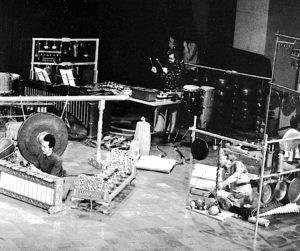
At Wesleyan U.
1973: EXPANSION We were performing “our own unique brand of improvised music”, says Bill, with the “simple desire to expand our own musicianship…There was absolutely no thought given to marketing – there was no market!” 1973 took us to the CBC Winnipeg Festival and also brought us our first foray into film music for Canadian screenwriter Paul Almond’s complex “Journey” featuring Genevieve Bujold in an allegorical searching for self “outside the normal framework of space and time.” But it was a residency at Wesleyan University in Connecticut that got us thinking more seriously about being a professional ensemble. Russell and Bob were both grad students at Wesleyan, studying non-western music with master musicians Abraham Adzinyah (Ghana), Sumarsam (Indonesia) and Ramnad Rhagavan (India). NEXUS’ performance with them provided the opportunity to incorporate non-western musical aesthetics into our improvisations. We had to learn their music (as in their home cultures) aurally, without notation. The result was a significant development of our listening sensitivities, and our responses. It was amazing! We began to include the African music in particular in our programming, although obviously we were not African musicians. We did not want to be presumptuous. With Adzinyah’s blessing, and that of elders in his Ghanaian community who listened to our renditions, we resolved this concern by referring to the pieces as “inspired by the music of….” Read more in Bill’s “Unpopular Music”, billcahn@aol.com.
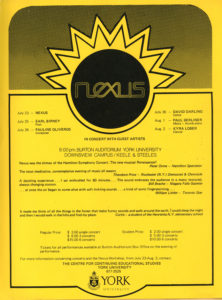 1973: THE SOUND OF NEXUS It had finally become clear to us that SOUND defined us. Over our 2 years we’d garnered feedback: The Hamilton (Ontario) Spectator wondered if this was “The new musical Renaissance?” The Toronto Star called the NEXUS experience “a kind of sonic fingerpainting” and the Niagara Falls Gazette spoke of sound embracing the audience in an “always changing cocoon”. Rhythmic groove or formal structure at times might be aspects of a NEXUS improvisation, but sound was our focal point. This was honed during our 2 week residency at York University (Toronto) in Summer‘73, where we collaborated with the distinguished poet Earle Birney, emerging American composer Pauline Oliveros, cello virtuoso David Darling, mbira artist Paul Berliner and dance artist Kyra Lober. At the time, Oliveros was teaching on the nature of music at the University of California-San Diego, advocating her concept of deep listening. For this performance she wrote “An Evening of Sonic Meditations”. Each of 4 sections consisted of instructions for the performers. The 3rd section, called Single Stroke Roll, was for NEXUS. The instructions: “NEXUS – Choose one instrument which you like, perform a single stroke roll until ‘it rolls’.” As Bill says, the challenge “was to focus deeply on hearing every sound”, an approach very much in sync with our interest in improvisation. This York residency was also the occasion of the infamous moment where Bill blurted, “Hey guys, we’ve got a stage full of instruments. Let’s begin by playing imaginary sounds – we’ll go through the motions of playing them!” Yes, continuing metaphysical speculation on the nature of sound. Each entered, one by one, and began producing imaginary sounds, with Bill being last and carefully imagining his perfect stroke on a bell – so perfect that he thought, “Gee! I can actually hear the bell.” Yup, he actually HIT the bell (perfectly) and its “sound cut through the imagined sounds like a freight train plowing through a sheet of tissue paper.” To this day, no one is sure if he set it up as a joke – “the mere suggestion of which I would categorically deny.” Read more in Bill’s “Unpopular Music”, billcahn@aol.com
1973: THE SOUND OF NEXUS It had finally become clear to us that SOUND defined us. Over our 2 years we’d garnered feedback: The Hamilton (Ontario) Spectator wondered if this was “The new musical Renaissance?” The Toronto Star called the NEXUS experience “a kind of sonic fingerpainting” and the Niagara Falls Gazette spoke of sound embracing the audience in an “always changing cocoon”. Rhythmic groove or formal structure at times might be aspects of a NEXUS improvisation, but sound was our focal point. This was honed during our 2 week residency at York University (Toronto) in Summer‘73, where we collaborated with the distinguished poet Earle Birney, emerging American composer Pauline Oliveros, cello virtuoso David Darling, mbira artist Paul Berliner and dance artist Kyra Lober. At the time, Oliveros was teaching on the nature of music at the University of California-San Diego, advocating her concept of deep listening. For this performance she wrote “An Evening of Sonic Meditations”. Each of 4 sections consisted of instructions for the performers. The 3rd section, called Single Stroke Roll, was for NEXUS. The instructions: “NEXUS – Choose one instrument which you like, perform a single stroke roll until ‘it rolls’.” As Bill says, the challenge “was to focus deeply on hearing every sound”, an approach very much in sync with our interest in improvisation. This York residency was also the occasion of the infamous moment where Bill blurted, “Hey guys, we’ve got a stage full of instruments. Let’s begin by playing imaginary sounds – we’ll go through the motions of playing them!” Yes, continuing metaphysical speculation on the nature of sound. Each entered, one by one, and began producing imaginary sounds, with Bill being last and carefully imagining his perfect stroke on a bell – so perfect that he thought, “Gee! I can actually hear the bell.” Yup, he actually HIT the bell (perfectly) and its “sound cut through the imagined sounds like a freight train plowing through a sheet of tissue paper.” To this day, no one is sure if he set it up as a joke – “the mere suggestion of which I would categorically deny.” Read more in Bill’s “Unpopular Music”, billcahn@aol.com
1974: RAGTIME! The piece that began it all: Bob Becker’s arrangement of “Rainbow Ripples” by George Hamilton Green. We were invited to perform with the London (Ontario) Symphony in a Family Pops Concert. We would play one of our improvisations for the entire second half of the program unaccompanied. But this time, there was a change in format – Bob’s arrangement. Bill describes the plan: At the close of the improvisation, “Bob would gradually move over to the xylophone and the rest of us would go over to the two marimbas…[while] Michael would accompany by playing on a ‘kit’ of old damaged wood blocks, cowbells, and oddball toys….Bob kicked it off on an energetic tempo…It was like an infusion of 50,000 volts into each seat in audience. Their reaction was unqualified, overwhelming, and another dimension beyond anything we had experiences as a group until that time.” It was JOY! At the time, Green’s music was largely forgotten or (perhaps worse), frowned upon as “trite” or “old hat”, but Bob recognized something of importance. We couldn’t ignore the huge response. It inspired us to delve deeper. Today Bob’s and Bill’s arrangements of Green’s music are performed all over the world. Bill says, “In my opinion, Bob was single-handedly responsible for the revival of Green’s music to the great benefit of a new generation of audiences.” But this marked a change in how we approached our programming – we would now have to find time to get together to rehearse!! You can read more in Bill’s blog post on Green at https://bit.ly/30xS7c0
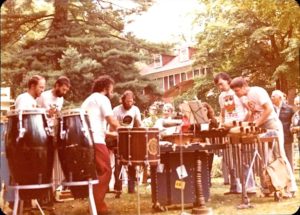
Outdoor concert, Chautauqua
1974: ORCHESTRA Five months after we introduced our 1st ragtime arrangement, we had enough arrangements to be able to perform our first all-ragtime xylophone concert right in the center of Chautauqua’s Bestor Plaza. During that week-long residency at the Chautauqua Institution, New York, NEXUS also performed with the Chautauqua Symphony conducted by Boris Brott but instead of performing solo on the program, this time we would be accompanied by the orchestra playing music that had been composed specifically to feature our eclectic instrument collection! The piece was “Bells” by NEXUS member John Wyre who was still timpanist with the Toronto Symphony. The percussion instrumentation was semi-improvised, and the notation unconventional – abstract coloured blotches on each orchestral musician’s page. A single rehearsal, significant challenges! Bill says, “There is no experience on this earth more difficult than attending a symphony orchestra’s first rehearsal of a work that you have composed yourself.” He remembers that, in the concert itself, “Somehow everyone dug deeply into their own resources of musicianship and the performance went well…with beautifully placed sounds but without the in-your-face harshness that characterized much of the abstract contemporary repertoire.” However, at the end of the performance, “the audience sat through one of those eternities of silence as a rack of suspended bells took several minutes to stop its motion…another classic NEXUS instance of having placed the audience in a situation where they didn’t know how to respond…It didn’t end until conductor Brott turned to face the audience to start the clapping. Needless to say, I had really enjoyed it….”
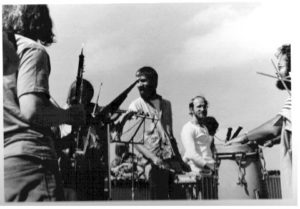
Courtenay, performing Terry Riley’s “In C”
We were at it again a few weeks later with the Courtenay Youth Music Camp Orchestra conducted by Simon Streatfeld, performing Bill’s “Stringless Harp” which, while experimental, did have standard notation! 1974 was “the beginning of numerous opportunities to connect with a powerful network of orchestra conductors with whom NEXUS would eventually collaborate.” Read more in Bill Cahn’s “Unpopular Music” available from billcahn@aol.com
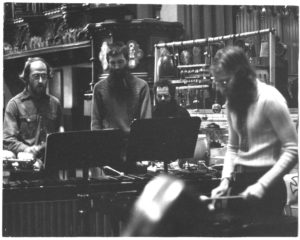
Russell, John, Michael and Bob
1974: CONNECTING We were three years old and connections were starting to be made. Boris Brott had conducted us with orchestra in Hamilton Ontario, and now again at Chautauqua. Among the crowd of onlookers at our Chautauqua ragtime recital was Dave Mancini who would go on to co-found the Eastman Marimba Band and Leigh Howard Stevens who would soon become the most influential marimba soloist and pedagogue in the world – and who would record with us in later years. Poet Earle Birney had appeared with us at York University and we would record with him too. Paul Horn worked with us at the Courtenay Youth Music Camp, and it would not be long before we were recording with him. Cellist David Darling had appeared with us at the York residency in ’73 and now he performed with us once again at St James Cathedral in Toronto (along with David Rosenbloom), recorded by the Canadian Broadcasting Corporation. In fact in 1974 we worked with a number of interesting and varied artists: East Asian musician Kumrud Banarjee, jazz vocalist Yolanda Bavan, and dulcimer expert Mitzie Collins. Our improvising format worked well for all sorts of collaborations, and our rag arrangements made for wonderful encores. We ended the year at Ithaca College – and in a “full circle” sort of moment, we recently were delighted to be the featured convocation artists at Ithaca in 2018. Photo: performing at St James Cathedral in Toronto, March 1974.
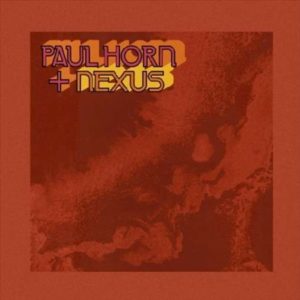 1975: FIRST ALBUM! Paul Horn already had some 17 recordings to his credit by 1975, including the wildly successful Inside
1975: FIRST ALBUM! Paul Horn already had some 17 recordings to his credit by 1975, including the wildly successful Inside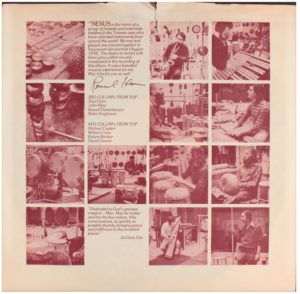 (1969) that he recorded inside the Taj Mahal. Not only was that album entirely improvised – it also was clear that Paul was as much in love with sound as we were. Having performed with Paul the previous year, he now joined us at Manta Sound (Toronto) in a series of inspired improvisations, performing on flutes and alto sax. “Paul Horn + NEXUS” was originally released on vinyl by Epic (KE33561) and was re-released on disc as “Altitude of the Sun” by Black Sun Records (15002-2), now a part of Celestial Harmonies in Tucson AZ. As you can see from the photos of the 1975 sessions (grainy as they are) the album is culturally diverse with influences from South America, Africa, India, Tibet and of course Paul’s jazz stylings too. You can still find a few copies of the original vinyl online, and the cover and liner notes are pictured here. The CD “Altitude of the Sun” combined “Paul Horn + NEXUS” with a recording Paul made in 1976 with the brilliant Brazilian guitarist Egberto Gismonti, originally titled “Altura do Sol”. CD Universe lists “Altitude…”, calling NEXUS “a touring group of percussionists and musical instrument collectors who hail from Toronto, Canada” and saying “Both of these LP’s, now combined on a single CD, have withstood the test of time. Both are as fresh and vital today as when they were originally recorded. Both are rooted in exciting multi-cultural rhythms. Both feature exceptional musicianship. Both transcend the musical biases and limitations of industrialized Western civilization. And both bring home to the listener a thrilling a deeply moving experience of diverse cultures joyfully united in shared humanity through the celebratory powers of music.”
(1969) that he recorded inside the Taj Mahal. Not only was that album entirely improvised – it also was clear that Paul was as much in love with sound as we were. Having performed with Paul the previous year, he now joined us at Manta Sound (Toronto) in a series of inspired improvisations, performing on flutes and alto sax. “Paul Horn + NEXUS” was originally released on vinyl by Epic (KE33561) and was re-released on disc as “Altitude of the Sun” by Black Sun Records (15002-2), now a part of Celestial Harmonies in Tucson AZ. As you can see from the photos of the 1975 sessions (grainy as they are) the album is culturally diverse with influences from South America, Africa, India, Tibet and of course Paul’s jazz stylings too. You can still find a few copies of the original vinyl online, and the cover and liner notes are pictured here. The CD “Altitude of the Sun” combined “Paul Horn + NEXUS” with a recording Paul made in 1976 with the brilliant Brazilian guitarist Egberto Gismonti, originally titled “Altura do Sol”. CD Universe lists “Altitude…”, calling NEXUS “a touring group of percussionists and musical instrument collectors who hail from Toronto, Canada” and saying “Both of these LP’s, now combined on a single CD, have withstood the test of time. Both are as fresh and vital today as when they were originally recorded. Both are rooted in exciting multi-cultural rhythms. Both feature exceptional musicianship. Both transcend the musical biases and limitations of industrialized Western civilization. And both bring home to the listener a thrilling a deeply moving experience of diverse cultures joyfully united in shared humanity through the celebratory powers of music.”
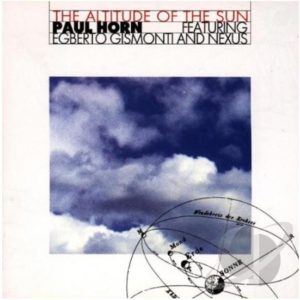 In 2010 the album was once again reissued by Wounded Bird/Inside Music. If you would like to hear it, go to https://amzn.to/3egP5gk where you can stream the tracks. In 2012 we spotted an Amazon.ca reviewer giving the new release 5 stars saying, “Wonderful album – finally re-issued!!! Five stars for a great album and five stars for Wounded Bird Records for re-issuing this…wonderful collaboration between NEXUS and Paul Horn. Paul Horn’s flute and saxophone is at times fast and jazzy, and at other times reflective and meditative. NEXUS add many percussive colours ranging from tabla drums to marimba. Always tasteful – yet masterful. A real gem if you like percussion and/or ‘world music’. The flavors here move from Indian to African to Jazz and back . . . African Funeral Song is very moving and tracks like Eastern Star and Dharma really catch fire.”
In 2010 the album was once again reissued by Wounded Bird/Inside Music. If you would like to hear it, go to https://amzn.to/3egP5gk where you can stream the tracks. In 2012 we spotted an Amazon.ca reviewer giving the new release 5 stars saying, “Wonderful album – finally re-issued!!! Five stars for a great album and five stars for Wounded Bird Records for re-issuing this…wonderful collaboration between NEXUS and Paul Horn. Paul Horn’s flute and saxophone is at times fast and jazzy, and at other times reflective and meditative. NEXUS add many percussive colours ranging from tabla drums to marimba. Always tasteful – yet masterful. A real gem if you like percussion and/or ‘world music’. The flavors here move from Indian to African to Jazz and back . . . African Funeral Song is very moving and tracks like Eastern Star and Dharma really catch fire.”
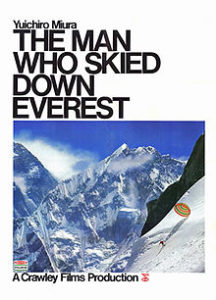 1974/1975: ACADEMY AWARD! Turns out free improvisation works well for film scores. Our film work had begun with Paul Almond’s “Journey” in ‘73. In 1974 “John Wyre and NEXUS” provided the score for Morley Markson’s “Monkeys in the Attic” – we believe Robin Engelman & Michael Craden were on this project. You can read about this “Film of Exploding Dreams” on the NEXUS blog: https://www.nexuspercussion.com/2012/11/monkeys-in-the-attic/ . The Fellini-esque film won the Prix Khalimer as well as Best Foreign Film at the ‘74 Toulon Film Festival (France). The soundtrack was described as “finely modulated and inventive”. The “clown” image here is actress Jackie Burroughs in the film. John Wyre wrote of the next project that came our way “…with Larry Crosley, a composer who had done many projects for Crawley Films. Budge Crawley had purchased some Japanese footage shot in the Himalayas, documenting Yuichiro Miura’s attempt to ski down Mt. Everest. The footage was stunning, and Crosley approached me to see if NEXUS could be involved in his score…I suggested he consider bringing Bob Aitken, the incredible flutist, together with NEXUS and have us improvise to the film…We filled the studio at Manta Sound (Toronto) with our instruments…The movie was screened directly into the studio. Crosley…would describe each scene and set the mood, then we played to picture. We worked for two days with no contract, no agreement on fees except the guarantee that if they were not happy with what we created we would return and play whatever score Crosley put together. The sessions were amazing, and when we finished Budge Crawley and his producer came…from the control booth, dancing in ecstasy, and we completed our negotiations in short order. The film, “The Man Who Skied Down Everest” won the Academy Award for Best Documentary of 1975,” and as John Wyre continues, “It confirmed the value of working in an improvisatory way and trusting the creative instincts of the musicians.” In his book “Unpopular Music”, Bill Cahn provides more details about these unconventional sessions, including “a hair-raising effect created by Michael Craden drumming on a Slinky toy that was duct taped to a tom-tom head for resonance”. Dave Greene was the engineer on the sessions – He had also engineered and mixed our Paul Horn album in ’75. Photo of the session was taken by Eric Cadesky when he was a mere slip of a lad. (“Unpopular Music” available from billcahn@aol.com
1974/1975: ACADEMY AWARD! Turns out free improvisation works well for film scores. Our film work had begun with Paul Almond’s “Journey” in ‘73. In 1974 “John Wyre and NEXUS” provided the score for Morley Markson’s “Monkeys in the Attic” – we believe Robin Engelman & Michael Craden were on this project. You can read about this “Film of Exploding Dreams” on the NEXUS blog: https://www.nexuspercussion.com/2012/11/monkeys-in-the-attic/ . The Fellini-esque film won the Prix Khalimer as well as Best Foreign Film at the ‘74 Toulon Film Festival (France). The soundtrack was described as “finely modulated and inventive”. The “clown” image here is actress Jackie Burroughs in the film. John Wyre wrote of the next project that came our way “…with Larry Crosley, a composer who had done many projects for Crawley Films. Budge Crawley had purchased some Japanese footage shot in the Himalayas, documenting Yuichiro Miura’s attempt to ski down Mt. Everest. The footage was stunning, and Crosley approached me to see if NEXUS could be involved in his score…I suggested he consider bringing Bob Aitken, the incredible flutist, together with NEXUS and have us improvise to the film…We filled the studio at Manta Sound (Toronto) with our instruments…The movie was screened directly into the studio. Crosley…would describe each scene and set the mood, then we played to picture. We worked for two days with no contract, no agreement on fees except the guarantee that if they were not happy with what we created we would return and play whatever score Crosley put together. The sessions were amazing, and when we finished Budge Crawley and his producer came…from the control booth, dancing in ecstasy, and we completed our negotiations in short order. The film, “The Man Who Skied Down Everest” won the Academy Award for Best Documentary of 1975,” and as John Wyre continues, “It confirmed the value of working in an improvisatory way and trusting the creative instincts of the musicians.” In his book “Unpopular Music”, Bill Cahn provides more details about these unconventional sessions, including “a hair-raising effect created by Michael Craden drumming on a Slinky toy that was duct taped to a tom-tom head for resonance”. Dave Greene was the engineer on the sessions – He had also engineered and mixed our Paul Horn album in ’75. Photo of the session was taken by Eric Cadesky when he was a mere slip of a lad. (“Unpopular Music” available from billcahn@aol.com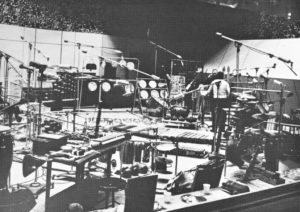 . John Wyre’s words are from his book“Touched By Sound”.)
. John Wyre’s words are from his book“Touched By Sound”.)
